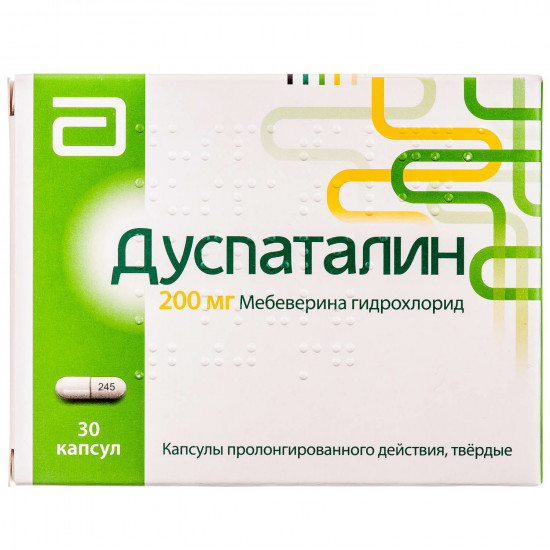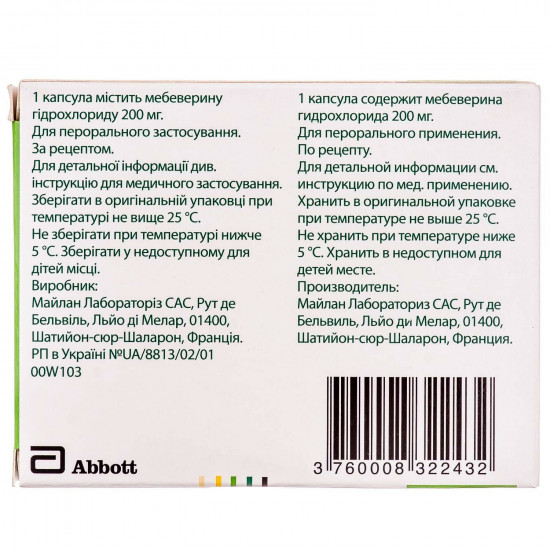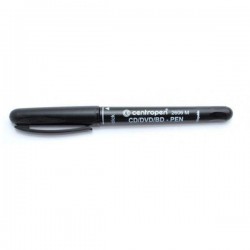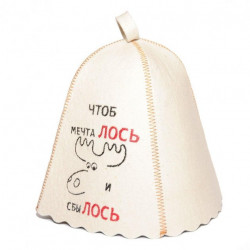



- Stock: In Stock
- Model: 184564
0% Customers recommend this product
-
5 Awesome0%
-
4 Great0%
-
3 Average0%
-
2 Bad0%
-
1 Poor0%
Reviews Over Duspatalin kaps. it is firm. 200 mg No. 30
- (0)
Total Reviews (0)
click here write review to add review for this product.
Report this review.
Description
Structure and form of release
Structure
Active ingredient: hydrochloride of a mebeverin;
1 capsule contains a hydrochloride of a mebeverin 200 mg;
Excipients: stearate of magnesium, methacrylate copolymer dispersion, talc, gipromeloza, polyacrylate dispersion, glitserol triacetate;
Rigid gelatin capsule (size No. 1): titan dioxide (E 171), gelatin.
a release Form
Capsule of the prolonged action, rigid.
Pharmacological properties
Pharmacodynamics
Mechanism of action and pharmakodinamichesky effects. Mebeverin is myotropic spasmolysant with selective effect on unstriated muscles of a digestive tract. It eliminates spasms without oppression of normal motility of intestines. As this action is not mediated by autonomous nervous system, there are no typical anticholinergic side effects.
Clinical performance and safety of use of various dosage forms of a mebeverin were studied bymore than 1500 patients. Considerable weakening of primary symptoms of a syndrome of the angry intestines (for example an abdominal pain, characteristics of a chair) were usually observed in the reference and controlled on the main by values clinical trials.
All dosage forms of a mebeverin were in general safe and were well transferred at the recommended dosing mode.
Children. Clinical trials of tablets or capsules were carried out only at adults. Given to clinical performance and safety on clinical trials and also post-marketing experience of use of suspension of a mebeverin pamoat at patients aged from 3 years was shown that mebeverin is effective safe medicine, it is well transferred.
Clinical trials of suspension of a mebeverin showed that it is effective for weakening of symptoms of a syndrome of the angry intestines at children. The further open researches of suspension of a mebeverin controlled on the main by values confirmed efficiency of drug.
Mode of dosing of tablets or capsules is calculated byon the basis of safety and shipping of a mebeverin.
Pharmacokinetics
Absorption. Mebeverin is quickly and completely absorbed after oral administration in the form of tablets. Thanks to the prolonged release of medicament from the capsule it is possible to accept it 2 times a day.
Distribution. At repeated use of Duspatalin of considerable cumulation does not arise.
Metabolism. Meverina a hydrochloride is mainly metabolized by esterases which at the first stage of metabolism split radio bonds with formation of veratric acid and mebeverinovy alcohol. In blood plasma demetilkarboksilny acid (DMKK) is the main metabolite. T ½ DMKK in an equilibrium state — 5.77 h. At repeated use of capsules (on 200 mg 2 times a day) the C max for DMKK made 804 ng/ml, and t max — about 3 h. The relative bioavailability of capsules of the prolonged action was optimum with an average ratio of 97%.
Removal. Mebeverin is not brought in not reversed look, it is metabolized, and metabolites are removed almost completely. Veratric acid is removed with urine. Mebeverinovy alcohol is also removed by kidneys in the form of corresponding carboxyl or DMKK.
Children. Pharmacokinetic researches at children were not conducted.
Indication
Adults and children aged from 10 years:
- symptomatic treatment of abdominal pain and spasms, dysfunction of intestines and discomfort in intestines at a syndrome of the angry intestines;
- treatment of the gastrointestinal spasms of secondary genesis caused by organic diseases.
Use
For oral administration.
to wash downCapsule with enough water (not less than 100 ml). It is not recommended to chew because the covering of the capsule is intended for providing the mechanism of the prolonged release.
to Adults and children 10 years are aged more senior thanto accept on 1 capsule 2 times a day (in the morning and in the evening).
Duration of use is not limited to. If one or more doses it is passed, the patient has to accept the following dose as it is necessary. The passed dose(s) it is not necessary to accept in addition to regular doses.
Special populations. Dosing researches for patients of advanced age, patients with a renal failure and/or a liver were not conducted. Considering the available post-marketing data of specific risk for patients of advanced age, patients with a renal failure and/or a liver it is not revealed. Dose adjustment for above-mentioned groups of patients is not considered necessary.
Contraindication
Hypersensitivity to active agent or any of inactive components of drug.
Special instructions
Use during pregnancy and feeding by a breast
Exist only very limited data on use of a mebeverin for pregnant women. researches of reproductive toxicity at animals are insufficient. duspatalin it is not recommended to apply during pregnancy.
Does not know towhether gets mebeverin or its metabolites into breast milk. Excretion of a mebeverin in breast milk of animals is not investigated. Duspatalin it is not necessary to apply during feeding by a breast.
do not haveclinical data on influence on male or female fertility; however researches on animals do not demonstrate harmful effects of the medicament Duspatalin.
Children. It is not necessary to use Duspatalin capsules at children under 3 years due to the lack of clinical data to this age category. Also it is not necessary to apply Duspatalin, capsules, at children aged from 3 up to 10 years because of the high content of active ingredient.
to DriversResearch of influence on ability to drive the car and to work with mechanisms were not carried out by
. The Pharmakodinamichesky and pharmacokinetic profile and also post-marketing experience do not demonstrate any harmful effects on ability to drive the car and to work with mechanisms. to Side effects
by
It was reported about the following side reactions arising spontaneously during post-marketing use. frequency on the available data precisely cannot be determined.
byobserved allergic reactions mainly from skin.
from skin and hypodermic cellulose: urticaria, Quincke's disease, face edema and rash.
from the immune system: hypersensitivity (anaphylactic reactions).
Overdose
can theoretically be observed byAt overdose excitement of central nervous system. in cases of overdose of a mebeverin the symptoms were absent or they were lungs and quickly disappeared. the observed symptoms of overdose were neurologic or cardiovascular origin. specific antidote is unknown. symptomatic treatment is recommended. gastric lavage is recommended only in case of intoxication by numerous medicaments which is diagnosed during 1 h from the moment of intake of medicines. measures for decrease in absorption are not necessary.
byInteraction
conducted interaction researches with alcohol. the researches in vitro and in Vivo on animals showed lack of any interaction of a duspatalin and ethanol.
Storage conditions
In original packing at a temperature not above 25 °C. not to store at a temperature below 5 °C.
UADUS170340
Specifications
| Characteristics | |
| Active ingredients | Mebeverin |
| Amount of active ingredient | 200 mg |
| Applicant | Abbott |
| Code of automatic telephone exchange | A03AA04 Mebeverin |
| Interaction with food | It doesn't matter |
| Light sensitivity | Not sensitive |
| Market status | The branded generic |
| Origin | Chemical |
| Prescription status | According to the prescription |
| Primary packing | blister |
| Producer | MAYLAN LABORATORIES SAS |
| Quantity in packing | 30 capsules (2 blisters on 15 pieces) |
| Release form | capsules for internal use |
| Route of administration | Oral |
| Sign | Import |
| Storage temperature | from 5 °C to 25 °C |
| Trade name | Duspatalin |



















































